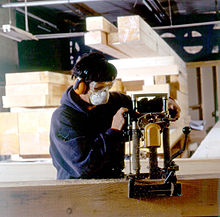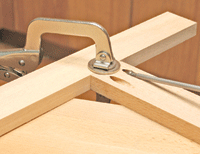
A mortiser or morticer is a specialized woodworking machine used to cut square or rectangular holes in a piece of lumber (timber), such as a mortise in a mortise and tenon joint.

A mortiser or morticer is a specialized woodworking machine used to cut square or rectangular holes in a piece of lumber (timber), such as a mortise in a mortise and tenon joint.

The square chisel mortiser (also called hollow chisel mortiser), similar to a drill press in many respects, combines the cutting of a four-sided chisel with the action of a drill bit in the center. The bit clears out most of the material to be removed, and the chisel ensures the edges are straight and clean. This device was invented in 1874 by Robert and Ralph Greenlee (founders of the Greenlee Company).
The first square chisel lever mortisers were purely manual and relied on the operator pulling down on a large lever to push the chisel through the timber. An improvement was to place a rotating cylindrical auger inside a hollow chisel. This helps to clear chips up the centre of the chisel. As electric power became easily available, the auger developed as a drill bit and became the main means of removing waste timber from the mortise. These mortisers now used much shorter hand levers, as the manual work was only in cleaning up the mortise to be square-cornered.
Square chisel mortising bits can also be fitted to normal drill presses using a mortising attachment.
The Greenlee Company still manufactures mortisers, as do a large number of other power tool manufacturers. It is a common tool in the woodshop of professional woodworkers, but because of its specialized nature, many amateur woodworkers would not make enough use of it to justify the moderately high cost and space this tool takes up in the woodshop. Some smaller and less expensive models, suitable for cutting only narrow mortises are available.
A more recent innovation is the horizontal mortiser, which incorporates a router mounted statically on its side with the workpiece clamped to a multi-axis sliding table. This type of mortiser can produce either traditional mortise and tenon pairs, however it excels at floating (or 'loose') tenons. A floating tenon is where both the pieces of wood that are to be joined have aligned mortises cut into them and a separate piece of wood is milled into a fitted tenon which is glued into the two mortises.

For cutting larger mortises such as those used in timber frame construction, chain mortisers are commonly used. A chain with cutters (similar to a chainsaw chain) rotating within a frame clamped to the work is successively plunged into the workpiece to mortise out the required volume. The Makita 7104L is such a tool. These chains are made in varying widths, with numbers of chains in parallel. The teeth are often solid or tipped tungsten carbide. They are thus very expensive, sometimes as much as the rest of the mortiser.

Traditionally, a mortise would be cut by hand, using a chisel and mallet. However, due to the precision of fit required for a mortise and tenon joint, this can be a difficult and time-consuming task.
Other tools such as a router could be used for the task, but the router usually requires special attachments, jigs or templates and the router bit leaves rounded corners that might need to be squared by hand with a chisel. Alternatively, the tenon can be rounded with a rasp to achieve an equally strong joint.
For cutting small mortises, a normal drill bit can be used. However, for larger mortises, a common type of bit in modern mortisers is a Harry Watt square drill bit, in which a bit with a Reuleaux triangle cross section is allowed to "wobble" while it rotates within a square with rounded corners[ citation needed ]. This type of bit removes all but the corners of the material to be removed, leaving very little to be cut by the chisel.

The router is a power tool with a flat base and a rotating blade extending past the base. The spindle may be driven by an electric motor or by a pneumatic motor. It routs an area in hard material, such as wood or plastic. Routers are used most often in woodworking, especially cabinetry. They may be handheld or affixed to router tables. Some woodworkers consider the router one of the most versatile power tools.

A chisel is a tool with a characteristically shaped cutting edge of blade on its end; for carving or cutting a hard material such as wood, stone, or metal by hand, struck with a mallet, or mechanical power. The handle and blade of some types of chisel are made of metal or wood with a sharp edge in it.

A mortiseand tenon joint connects two pieces of wood or other material. Woodworkers around the world have used it for thousands of years to join pieces of wood, mainly when the adjoining pieces connect at right angles.

A drill is a tool used for making round holes or driving fasteners. It is fitted with a bit, either a drill or driver chuck. Hand-operated types are dramatically decreasing in popularity and cordless battery-powered ones proliferating due to increased efficiency and ease of use.

Drill bits are cutting tools used in a drill to remove material to create holes, almost always of circular cross-section. Drill bits come in many sizes and shapes and can create different kinds of holes in many different materials. In order to create holes drill bits are usually attached to a drill, which powers them to cut through the workpiece, typically by rotation. The drill will grasp the upper end of a bit called the shank in the chuck.

A hand plane is a tool for shaping wood using muscle power to force the cutting blade over the wood surface. Some rotary power planers are motorized power tools used for the same types of larger tasks, but are unsuitable for fine-scale planing, where a miniature hand plane is used.

Drilling is a cutting process where a drill bit is spun to cut a hole of circular cross-section in solid materials. The drill bit is usually a rotary cutting tool, often multi-point. The bit is pressed against the work-piece and rotated at rates from hundreds to thousands of revolutions per minute. This forces the cutting edge against the work-piece, cutting off chips (swarf) from the hole as it is drilled.

A biscuit joiner or biscuit jointer is a woodworking tool used to join two pieces of wood together. A biscuit joiner uses a small circular saw blade to cut a crescent-shaped hole in the opposite edges of two pieces of wood or wood composite panels. An oval-shaped, highly dried and compressed wooden biscuit is covered with glue, or glue is applied in the slot. The biscuit is immediately placed in the slot, and the two boards are clamped together. The wet glue expands the biscuit, further improving the bond.

A wood shaper, is a stationary woodworking machine in which a vertically oriented spindle drives one or more stacked cutter heads to mill profiles on wood stock.

A vise or vice is a mechanical apparatus used to secure an object to allow work to be performed on it. Vises have two parallel jaws, one fixed and the other movable, threaded in and out by a screw and lever.

A butt joint is a wood joint in which the end of a piece of material is simply placed against another piece. The butt joint is the simplest joint. An unreinforced butt joint is also the weakest joint, as it provides a limited surface area for gluing and lacks any mechanical interlocking to resist external forces.
In the context of machining, a cutting tool or cutter is typically a hardened metal tool that is used to cut, shape, and remove material from a workpiece by means of machining tools as well as abrasive tools by way of shear deformation. The majority of these tools are designed exclusively for metals.

The Woodwright's Shop is an American traditional woodworking show hosted by master carpenter Roy Underhill and airing on television network PBS. It is one of the longest running how-to shows on PBS, with thirty-five 13-episode seasons produced. Since its debut in 1979, the show has aired over 400 episodes. The first two seasons were broadcast only on public TV in North Carolina; the season numbering was restarted when the show went national in 1981. It is filmed at the UNC-TV studios in Research Triangle Park, North Carolina.

Pocket-hole joinery, or pocket-screw joinery, involves drilling a hole at an angle — usually 15 degrees — into one work piece, and then joining it to a second work piece with a self-tapping screw.

A bridle joint is a woodworking joint, similar to a mortise and tenon, in that a tenon is cut on the end of one member and a mortise is cut into the other to accept it. The distinguishing feature is that the tenon and the mortise are cut to the full width of the tenon member.
This glossary of woodworking lists a number of specialized terms and concepts used in woodworking, carpentry, and related disciplines.
Greenlee is an American industrial and electrical tool company headquartered in Rockford, Illinois. It was founded in 1862 by twin brothers Robert L. and Ralph S. Greenlee to manufacture their invention, a drill surrounded by four chisel blades, used in making the pockets for a mortise and tenon joint, for the furniture industry in Rockford. This device is still used in cabinetmaking. The brothers later diversified into a variety of hand woodworking tools as well as machinery for making wooden barrels.

A twybil is a hand tool used for green woodworking. It is used for chopping out mortises when timber framing, or making smaller pieces such as gates. It combines chopping and levering functions in a single tool.

A carpenters boring machine is a hand-driven machine to bore holes in beams such in the process of making a mortise or making holes for the wooden pegs which hold mortise and tenon joints together.